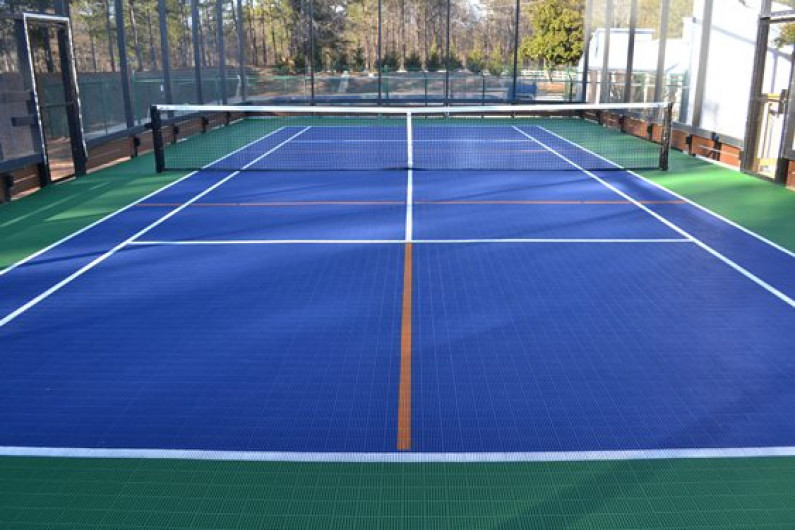Understanding the Timeline for Your Pickleball Court Construction Project
Understanding the Timeline for Your Pickleball Court Construction Project
Blog Article
Boost Resident Interaction With Community-Driven Pickleball Court Projects
The emergence of community-driven pickleball court tasks offers an unique possibility to cultivate neighborhood interaction and enhance neighborhood ties. The genuine inquiry remains: exactly how can these grassroots efforts be tactically executed to make sure sustainability and inclusivity in diverse communities?
Value of Community Interaction
Area engagement is a crucial aspect in the successful development of pickleball court tasks, as it cultivates a feeling of ownership and collective duty amongst residents. When area members are proactively involved in the planning and application phases, they are most likely to support for the job's long-term success. Engaging stakeholders such as local gamers, households, and entertainment teams makes certain that the facilities satisfy the varied needs and preferences of the community.
Moreover, community interaction grows an encouraging atmosphere where homeowners really feel empowered to contribute their resources and concepts. Pickleball court construction. This joint approach can cause ingenious solutions that improve the layout and functionality of the courts, making them a lot more attractive to a bigger audience. In addition, entailing locals in decision-making processes can enhance social connections, advertising inclusivity and unity within the area
The exposure of neighborhood support for a pickleball job can likewise play a crucial function in protecting financing and authorization from local authorities. By showing a common dedication to entertainment growth, communities can efficiently advocate for resources and policy changes that prefer the establishment of pickleball courts, ultimately enriching the regional society and recreational landscape.
Steps to Initiate a Project
Starting a pickleball court task requires an organized approach that constructs on the foundation of neighborhood engagement developed in previous discussions. The very first step is to put together a project committee consisting of local stakeholders, lovers, and agents from relevant organizations. This varied group guarantees that several point of views are considered.
Next, carry out a needs analysis within the area. Surveys, emphasis groups, and public conferences can be reliable in assessing rate of interest and gathering input on prospective court areas, preferred features, and organizing choices. Following this, establish a task plan describing duties, timelines, and goals.
As soon as the strategy remains in place, involve with regional authorities to comprehend zoning policies and any type of necessary permits. Connecting transparently with the area throughout this process is critical, as it promotes trust fund and encourages more engagement.
Furthermore, organizing community events can aid preserve energy and enthusiasm. These events can function as platforms for further discussion and help to reinforce neighborhood ties. Last but not least, record every step taken and maintain thorough records, as this will be useful for future phases of the task, including funding and resource purchase.
Financing and Resources Available
Protecting funding and sources for a pickleball court project is often a critical action that can determine the task's feasibility and success. Numerous opportunities exist for obtaining financial backing, varying from public funding to private sponsorships. City government grants, frequently focused on advertising community wellness and recreation, can give considerable sponsorship for such campaigns.
Along with federal government sources, nonprofit companies and foundations often supply grants particularly for sporting activities and community advancement projects. Engaging regional businesses as sponsors can also be a productive approach; lots of companies are excited to spend in community efforts that improve their company social responsibility profile.
Crowdfunding systems have actually emerged as a practical choice for grassroots fundraising, allowing area participants to add straight to the task. This approach not only raises funds however likewise promotes a sense of ownership among participants.
Style and Planning Considerations
Efficient style and preparation are essential elements of any type of successful pickleball court job complying with the purchase of funding and resources. A comprehensive assessment of the proposed location is essential; this includes analyzing accessibility, proximity to existing area services, and the capacity for exposure and engagement.
The layout of the court have to follow official size specifications while taking into consideration the bordering atmosphere. Incorporating features such as seats, shade structures, and ideal illumination can substantially enhance gamer experience and spectator enjoyment. Products chosen for the court surface need to focus on toughness and security, with options like acrylic or asphalt offering ideal performance.
Entailing neighborhood members in the style process cultivates a sense of possession and guarantees that the center satisfies local requirements - Pickleball court construction. This can be achieved via public assessments and studies, permitting stakeholders to express their choices and concerns
Sustainability must also be a top priority; incorporating eco-friendly products and techniques can contribute to lasting practicality. Creating a maintenance strategy to ensure the court stays in exceptional problem will support recurring area engagement and involvement in pickleball tasks.

Success Stories and Study
Highlighting the transformative effect of community-driven initiatives, numerous success stories illustrate just how collaborative initiatives have caused the advancement of dynamic pickleball courts throughout different areas. One significant example is the effort in a small community in Florida, where locals united to convert an underutilized tennis court right into a specialized pickleball facility. Via fundraising occasions and partnerships with neighborhood companies, the area increased enough funds to install brand-new nets, resurfacing, and lines, eventually cultivating a lively center for neighborhood players.
Likewise, in a suburb of The golden state, a grassroots movement emerged to develop pickleball courts in a local park. The job useful site not just involved volunteers for building yet also consisted of workshops to involve community members in the Get More Info sporting activity. Therefore, the courts became a prime focus for social communication and fitness, drawing in gamers of every ages.
These study exhibit just how community-driven projects can improve regional interaction, advertise physical activity, and strengthen social bonds. By leveraging collective resources and interest, areas can efficiently create and sustain pickleball facilities that offer varied populaces and cultivate a feeling of belonging.

Final Thought
By prioritizing stakeholder involvement throughout the planning and implementation stages, these efforts can properly address diverse community demands. Ultimately, such initiatives contribute to the transformation of public rooms right into dynamic centers of health and fitness and social interaction, enhancing neighborhood ties.
The emergence of community-driven pickleball court tasks presents an unique opportunity to foster regional interaction and enhance neighborhood connections.Community interaction is a critical element in the effective development of pickleball court tasks, as it cultivates a feeling of possession and cumulative duty visit the site amongst citizens. When neighborhood participants are proactively included in the planning and implementation stages, they are more most likely to support for the task's long-lasting success.Starting a pickleball court project requires a systematic approach that constructs on the structure of neighborhood interaction established in previous conversations. The task not only involved volunteers for construction but also consisted of workshops to involve neighborhood members in the sport.
Report this page